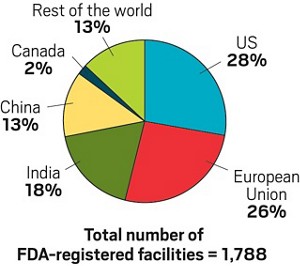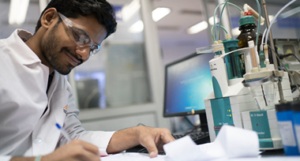Coronavirus & Drug Supply Chains: The Pharma Industry Searches for Answers

Coronavirus has impacted drug supply chains.
At first blush, people will likely read that sentence to mean drugs aren’t arriving at their intended destination. That precursor chemicals, intermediaries, APIs, or finished dosages – either by virtue of plant closures or government intervention –are not making it to where they need to go.
I don’t mean to say that shortages haven’t happened in various countries around the world (hydroxychloroquine, anyone?), but the reality is actually more subtle. It’s a tale of risk, and how companies are struggling – in very short time frames – to minimize and control it.
Neuland has explored this topic before – but it was never widely regarded as an urgent subject until recently. The reality is everyone is feeling this crunch. While Neuland actually has a leg up on this issue (more on that later), the reality of complex, multinational, interdependent supply chains means this issue affects the industry en bloc.
The Focus on China
China – widely presumed to be the originating source of the novel coronavirus – has been the focus of supply chain attentions, most notably in the West but also in countries like India.
Pharma – collectively, as an industry – have become heavily reliant on China over the last few decades. Precursor chemicals, intermediates for APIs and APIs themselves are often sourced from China. And while popular reports that as much as 80% of drugs come from – or rely in some fashion upon – China haven’t been substantiated, there is considerable dependence on Chinese manufacturers.
This situation has been driven over the decades by a number of factors. Two of the biggest are environmental/pollution issues and increasing drug industry cost pressures.
• Environmental Issues
Upstream chemical manufacturing generates a tremendous quantity of waste during the production of precursor chemicals and intermediates. Downstream pharmaceutical processing to create APIs can generate additional significant chemical waste.Solvents such as acetone, benzene, ethanol, isopropanol, toluene and many others are produced (and used) in massive quantities across the drug manufacturing process. According to Millipore Sigma, “Solvents constitute more than half the material used in the manufacture of active pharmaceutical ingredients in the pharmaceutical industry.”Over the last 50 years, as countries such as the U.S. put environmental controls in place, a great deal of manufacturing was transitioned first to India and then, later, China. In recent years, however, China itself hasn’t been immune to environmental concerns. In 2018, widespread crackdowns closed 144 API manufacturers in the Beijing-Tianjin-Hebei region alone – cutting off supplies of a wide range of chemicals and APIs and leading to short-term global shortages of several drugs.Most intermediates are no longer manufactured in Europe or the U.S. In many cases, the infrastructure and requisite expertise no longer exists. The time frames necessary to restart production would be significant. Even if accomplished, reshoring the production of bulk chemicals will still face high regulatory burdens.The promise of “green manufacturing” (we’ve referenced it before, for example: Green Chemistry and Benign by Design – Sept. 2015, Embracing Green Chemistry – Dec. 2015, Synthetic Route Scouting: Factors to Improve API Manufacturing – Jan. 2018) can alleviate some of the issues of effluent & waste generation, but realistically not all. Emerging techniques are making a difference, but it has yet to reach a critical mass at which environmental concerns cease to be a manufacturing consideration across the board.
• Cost Pressures
Compared to the U.S. and Europe, ROW (Rest of World) offers tremendous labor cost savings. These cost perks, however, were not strictly in the realm of manpower. In the U.S., for example, Puerto Rico lost its drug-making luster when the Section 936 federal tax incentive was phased out, drug manufacturers went further offshore in search of cost savings. With its entry into the WTO and a rapidly expanding industrial & manufacturing infrastructure, China eventually became a dominant player.
Some of the cost advantages of manufacturing in China have faded. The closures and environmental-related issues mentioned above have revised some pricing – especially in relation to hazardous or polluting chemical production (for example, boron chemistry).
Despite China’s scale advantage, tightening restrictions have made it possible for India to re-emerge as a competitive alternative. This is especially true of precursors and intermediates in which process improvements can bend the cost curve to eliminate offshore advantages.
The Hot Question: Will the U.S. Bring Pharma Manufacturing Back Onshore?
The factors discussed above – and numerous others – led the shift away from domestic production in large parts of the world. As these points indicate, the conditions for their return to home countries – whether in the E.U., the U.S. or elsewhere – will likely never materialize en masse, though some repatriation is likely to occur.

However, labor costs won’t decline in the U.S. Environmental restrictions on large scale manufacturing won’t ease up in Europe. Neither region possesses either the infrastructure – or the muscle memory – for a quick repatriation and reboot of manufacturing.
In fact, some trends tend to indicate the opposite of repatriation is still happening. By the time this post publishes, Novartis will likely have closed a deal to offshore “about 300 generics drugs that it no longer felt were worth keeping, along with three U.S. manufacturing facilities.”
With all of this being said, it isn’t impossible for repatriation of manufacturing to occur…and COVID-19 may provide sufficient incentive to make it happen. Some reshoring is to be expected: higher volume, higher margin products may find their way back to domestic production.
There have been numerous articles about reducing reliance on overseas production of key critical drugs, though the definition of that category shifts depending on the condition or disease (antibiotics, for example, are considered critical, though they reportedly have no impact on viral diseases such as COVID-19).
A more likely outcome will be a shift towards redundancies – secondary manufacturers, backup facilities, multi-region supply arrangements, avoidance (wherever possible) of single-source providers and more. These tactics won’t focus solely on finished dosages, but will increasingly encompass the entire supply chain, starting with the furthest upstream precursor chemicals.
How Can Pharma Improve Supply Chain Security?
This is a question that will likely persist long after COVID-19 has run its course around the world – and it difficult to speculate what might happen. To shed some light, we can share some of the steps Neuland has taken – and where we see opportunities to further secure supply chains.
The temporary closures of Chinese factories in 2018 (referenced above) raised sufficient supply chain anxiety that we began effecting a shift in our own sourcing philosophy. Here is a brief survey of some of the steps we’ve either taken to address our own concerns and those of our customers around the world, or strategies we have seen gain prominence:

• Manufacturing Facility Expansion
In 2018, we acquired a third manufacturing facility. The key focus of the acquisition was to provide significantly increased operational flexibility (it boosted our manufacturing capacity by about 40%). This facility offers redundancy for existing API manufacturing, allowing seamless transition in the event of an unexpected shutdown of existing production lines.
• Backward Integration
One particular strategy we adopted several years ago (and continue to ramp up today) focuses on backward integrating our own supply chains. Neuland has ramped up our own production of several key intermediaries internally to reduce reliance on foreign manufacturers.This step was originally taken to control NCE & generic API costs, but has proven itself a valuable strategy in light of the abovementioned pollution-driven shutdowns, political instability, trade wars and now coronavirus. While a rapid switch to alternatives faces significant hurdles (qualification can take 7 months…and up to 2 years), we see it as an essential step to take in order to safeguard supply.
• Intra-China Geographic Dispersion
Whatever may happen, some manufacturing – especially smaller volume, low margin APIs – will likely always remain in China. One strategy to reduce future risk is to ensure regional dispersion.Lower population density areas outside of Shanghai and Beijing – whether in Inner Mongolia, Sichuan, Northeast China or elsewhere – will likely become more popular API & intermediate destinations of choice. The best de-risking option? Qualifying multiple sources – both inside and outside of China.
• Improved Regulatory Coordination
The coronavirus pandemic has seen pharma companies working closely with regulatory agencies to prevent or address potential shortages. In our case, we have been fortunate that the U.S. FDA provided some sort of accelerated approval of a new source, which should – at the time this post is published – be online, allowing us some velocity in scaling up an API. In recent years, we’ve seen regulatory agencies increasingly willing to expedite clearances & approvals to forestall shortages.
• Ensuring Adequate Inventories
Neuland has taken steps to ensure adequate inventories of key products in the event of circumstances such as coronavirus. Such efforts occur on a case-by-case basis, and rely on the outcomes of supply chain risk analysis, as some products (and the precursors and intermediates they depend upon) are higher risk than others.
While reliance on China may fade, it won’t wholly disappear. This is the nature of global trade. With that being said, qualification of non-Chinese sources is likely to be a top-of-mind issue as the industry looks to de-risk global drug supplies.
Source : neulandlabs